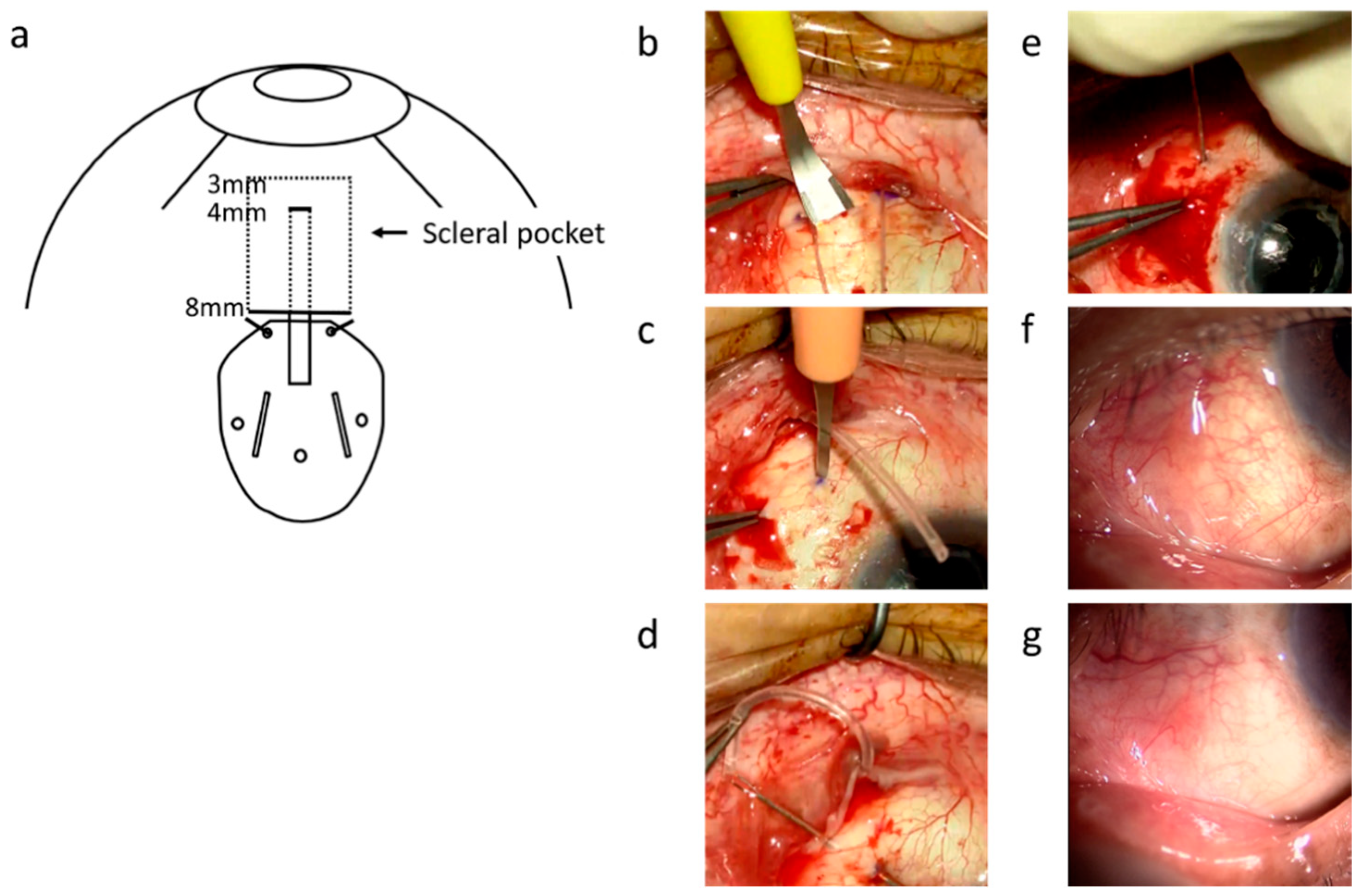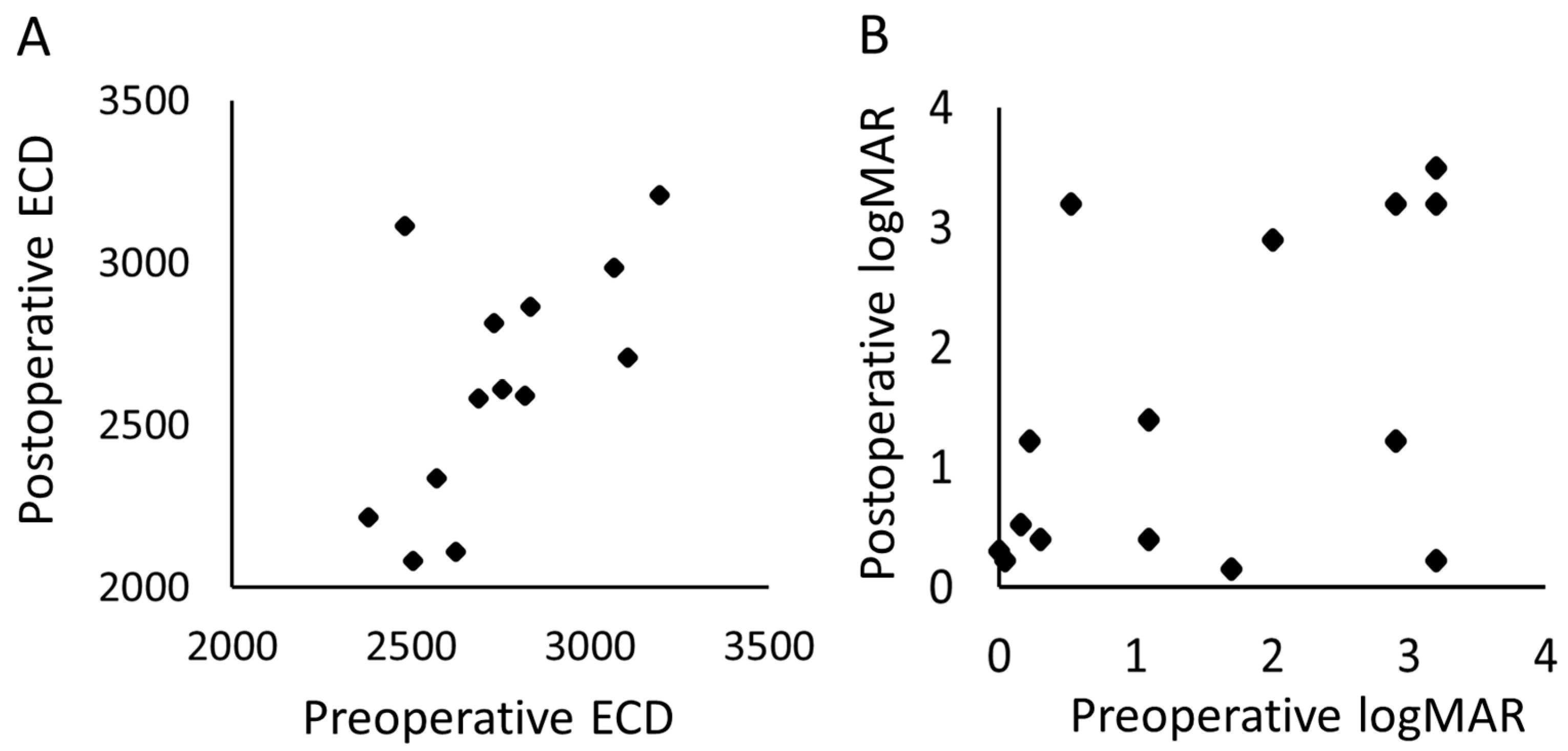Autologous Scleral Pocket Technique for Ahmed Glaucoma Valve Implantation with Pars Plana Tube Insertion for Neovascular Glaucoma
Abstract
1. Introduction
2. Materials and Methods
2.1. Patients
2.2. Surgical Procedure
2.3. Ocular Biometrics
2.4. Data Analysis
3. Results
4. Discussion
Supplementary Materials
Author Contributions
Funding
Institutional Review Board Statement
Informed Consent Statement
Data Availability Statement
Conflicts of Interest
References
- Sidoti, P.A.; Dunphy, T.R.; Baerveldt, G.; LaBree, L.; Minckler, D.S.; Lee, P.P.; Heuer, D.K. Experience with the Baerveldt glaucoma implant in treating neovascular glaucoma. Ophthalmology 1995, 102, 1107–1118. [Google Scholar] [CrossRef]
- Netland, P.A. The Ahmed glaucoma valve in neovascular glaucoma (An AOS Thesis). Trans. Am. Ophthalmol. Soc. 2009, 107, 325–342. [Google Scholar] [PubMed]
- Netland, P.A.; Ishida, K.; Boyle, J.W. The Ahmed Glaucoma Valve in patients with and without neovascular glaucoma. J. Glaucoma 2010, 19, 581–586. [Google Scholar] [CrossRef]
- Shen, C.C.; Salim, S.; Du, H.; Netland, P.A. Trabeculectomy versus Ahmed Glaucoma Valve implantation in neovascular glaucoma. Clin. Ophthalmol. 2011, 5, 281–286. [Google Scholar] [PubMed]
- Cheng, Y.; Liu, X.H.; Shen, X.; Zhong, Y.S. Ahmed valve implantation for neovascular glaucoma after 23-gauge vitrectomy in eyes with proliferative diabetic retinopathy. Int. J. Ophthalmol. 2013, 6, 316–320. [Google Scholar]
- He, Y.; Tian, Y.; Song, W.; Su, T.; Jiang, H.; Xia, X. Clinical efficacy analysis of Ahmed glaucoma valve implantation in neovascular glaucoma and influencing factors: A STROBE-compliant article. Medicine 2017, 96, 8350. [Google Scholar] [CrossRef]
- Tojo, N.; Nakamura, T.; Ueda, T.C.; Yanagisawa, S.; Hayashi, A. Results of the Baerveldt® glaucoma implant for neovascular glaucoma patients. Nippon Ganka Gakkai Zasshi 2017, 121, 138–145. [Google Scholar]
- Suda, M.; Nakanishi, H.; Akagi, T.; Murakami, T.; Suzuma, K.; Suda, K.; Kameda, T.; Morooka, S.; Ikeda, H.O.; Tsujikawa, A. Baerveldt or Ahmed glaucoma valve implantation with pars plana tube insertion in Japanese eyes with neovascular glaucoma: 1-year outcomes. Clin. Ophthalmol. 2018, 12, 2439–2449. [Google Scholar] [CrossRef]
- Xie, Z.; Liu, H.; Du, M.; Zhu, M.; Tighe, S.; Chen, X.; Yuan, Z.; Sun, H. Efficacy of Ahmed glaucoma valve implantation on neovascular glaucoma. Int. J. Med. Sci. 2019, 16, 1371–1376. [Google Scholar] [CrossRef]
- Shalaby, W.S.; Myers, J.S.; Razeghinejad, R.; Katz, L.J.; Pro, M.; Dale, E.; Fudemberg, S.J.; Mantravadi, A.V.; Shukla, A.G. Outcomes of valved and nonvalved tube shunts in neovascular glaucoma. Ophthalmol. Glaucoma 2021, 4, 182–192. [Google Scholar] [CrossRef]
- Gedde, S.J.; Schiffman, J.C.; Feuer, W.J.; Herndon, L.W.; Brandt, J.D.; Budenz, D.L. Tube versus Trabeculectomy Study Group. Treatment outcomes in the Tube Versus Trabeculectomy (TVT) study after five years of follow-up. Am. J. Ophthalmol. 2012, 153, 789–803. [Google Scholar] [CrossRef]
- Zalta, A.H. Long-term experience of patch graft failure after Ahmed Glaucoma Valve® surgery using donor dura and sclera allografts. Ophthalmic. Surg. Lasers Imaging 2012, 43, 408–415. [Google Scholar] [CrossRef] [PubMed]
- Tamcelik, N.; Ozkok, A.; Sarıcı, A.M.; Atalay, E.; Yetik, H.; Gungor, K. Tenon advancement and duplication technique to prevent postoperative Ahmed valve tube exposure in patients with refractory glaucoma. Jpn. J. Ophthalmol. 2013, 57, 359–364. [Google Scholar] [CrossRef] [PubMed]
- Tsoukanas, D.; Xanthopoulou, P.; Charonis, A.C.; Theodossiadis, P.; Kopsinis, G.; Filippopoulos, T. Heterologous, fresh, human donor sclera as patch graft material in glaucoma drainage device surgery. J. Glaucoma 2016, 25, 558–564. [Google Scholar] [CrossRef]
- Van Hoefen Wijsard, M.; Haan, M.; Rietveld, E.; van Rijn, L.J. Donor sclera versus bovine pericardium as patch graft material in glaucoma implant surgery and the impact of a drainage suture. Acta Ophthalmol. 2018, 96, 692–698. [Google Scholar] [CrossRef] [PubMed]
- Tanji, T.M.; Lundy, D.C.; Minckler, D.S.; Heuer, D.K.; Varma, R. Fascia lata patch graft in glaucoma tube surgery. Ophthalmology 1996, 103, 1309–1312. [Google Scholar] [CrossRef]
- Brandt, J.D. Patch grafts of dehydrated cadaveric dura mater for tube-shunt glaucoma surgery. Arch. Ophthalmol. 1993, 111, 1436–1439. [Google Scholar] [CrossRef]
- Kugu, S.; Erdogan, G.; Sevim, M.S.; Ozerturk, Y. Efficacy of long scleral tunnel technique in preventing Ahmed glaucoma valve tube exposure through conjunctiva. Semin. Ophthalmol. 2015, 30, 1–5. [Google Scholar] [CrossRef] [PubMed]
- Singh, M.; Chew, P.T.; Tan, D. Corneal patch graft repair of exposed glaucoma drainage implants. Cornea 2008, 27, 1171–1173. [Google Scholar] [CrossRef]
- Ollila, M.; Falck, A.; Airaksinen, P.J. Placing the Molteno implant in a long scleral tunnel to prevent postoperative tube exposure. Acta Ophthalmol. Scand. 2005, 83, 302–305. [Google Scholar] [CrossRef]
- Pakravan, M.; Hatami, M.; Esfandiari, H.; Yazdani, S.; Doozandeh, A.; Samaeili, A.; Kheiri, B.; Conner, I. Ahmed glaucoma valve implantation: Graft-free short tunnel small flap versus scleral patch graft after 1-Year follow-up: A randomized clinical trial. Ophthalmol. Glaucoma 2018, 1, 206–212. [Google Scholar] [CrossRef]
- Ozdamar, A.; Aras, C.; Karacorlu, M. Suprachoroidal seton implantation in refractory glaucoma: A novel surgical technique. J. Glaucoma 2003, 12, 354–359. [Google Scholar] [CrossRef] [PubMed]
- Mesa-Gutiérrez, J.C.; Lillo-Sopena, J.; Monés-Llivina, A.; Sanz-Moreno, S.; Arruga-Ginebreda, J. Graft-free Ahmed tube insertion: A modified method at 5 mm from limbus. Clin. Ophthalmol. 2010, 4, 359–363. [Google Scholar] [CrossRef] [PubMed][Green Version]
- Ma, X.H.; Du, X.J.; Liu, B.; Bi, H.S. Modified scleral tunnel to prevent tube exposure in patients with refractory glaucoma. J. Glaucoma 2016, 25, 883–885. [Google Scholar] [CrossRef] [PubMed]
- Mori, S.; Sakamoto, M.; Kurimoto, T.; Kanamori, A.; Ueda, K.; Inoue, Y.; Yamada, Y.; Nakamura, M. Effectiveness and safety of sulcus fixation of Baerveldt glaucoma implants in glaucomatous eyes in patients who underwent multiple intraocular surgeries. Graefes. Arch. Clin. Exp. Ophthalmol. 2018, 256, 1953–1960. [Google Scholar] [CrossRef]
- Iwasaki, K.; Arimura, S.; Takihara, Y.; Takamura, Y.; Inatani, M. Prospective cohort study of corneal endothelial cell loss after Baerveldt glaucoma implantation. PLoS ONE 2018, 13, e0201342. [Google Scholar] [CrossRef]
- Tojo, N.; Hayashi, A.; Consolvo-Ueda, T.; Yanagisawa, S. Baerveldt surgery outcomes: Anterior chamber insertion versus vitreous cavity insertion. Graefes. Arch. Clin. Exp. Ophthalmol. 2018, 256, 2191–2200. [Google Scholar] [CrossRef]
- Mori, S.; Sotani, N.; Ueda, K.; Sakamoto, M.; Kurimoto, T.; Yamada-Nakanishi, Y.; Nakamura, M. Three-year outcome of sulcus fixation of Baerveldt glaucoma implant surgery. Acta Ophthalmol. 2021. [Google Scholar] [CrossRef]
- Zhang, Q.; Liu, Y.; Thanapaisal, S.; Oatts, J.; Luo, Y.; Ying, G.S.; Wang, J.; McLeod, S.D.; Gedde, S.J.; Han, Y. The effect of tube location on corneal endothelial cells in patients with Ahmed glaucoma valve. Ophthalmology 2021, 128, 218–226. [Google Scholar] [CrossRef]



| Age, Years | 67.7 (11.3) |
|---|---|
| Sex | Male: 8 (53%) Female: 7 (47%) |
| Primary diseases of NVG | PDR: 7 (47%) RVO: 6 (40%) OIS: 2 (13%) |
| Post-vitrectomy | 7 (47%) |
| IOP, mmHg | 37.2 (13.8) |
| Glaucoma drug score | 4.2 (2.2) |
| ECD (cells/mm2) | 2687.1 (304.6) |
| Vitreous Hemorrhage | 6 (40%) |
|---|---|
| Hyphema | 4 (27%) |
| Choroidal detachment | 3 (20%) |
| Macular edema | 1(7%) |
| Iris posterior synechia | 1 (7%) |
| Hypotony maculopathy | 1 (7%) |
| Additional glaucoma surgery | 1 (7%) |
| Tube erosion, conjunctival erosions | 0 (0%) |
Publisher’s Note: MDPI stays neutral with regard to jurisdictional claims in published maps and institutional affiliations. |
© 2021 by the authors. Licensee MDPI, Basel, Switzerland. This article is an open access article distributed under the terms and conditions of the Creative Commons Attribution (CC BY) license (https://creativecommons.org/licenses/by/4.0/).
Share and Cite
Maki, H.; Mori, S.; Imai, H.; Yamada, H.; Otsuka, K.; Miki, A.; Kusuhara, S.; Nakamura, M. Autologous Scleral Pocket Technique for Ahmed Glaucoma Valve Implantation with Pars Plana Tube Insertion for Neovascular Glaucoma. J. Clin. Med. 2021, 10, 1606. https://doi.org/10.3390/jcm10081606
Maki H, Mori S, Imai H, Yamada H, Otsuka K, Miki A, Kusuhara S, Nakamura M. Autologous Scleral Pocket Technique for Ahmed Glaucoma Valve Implantation with Pars Plana Tube Insertion for Neovascular Glaucoma. Journal of Clinical Medicine. 2021; 10(8):1606. https://doi.org/10.3390/jcm10081606
Chicago/Turabian StyleMaki, Hitomi, Sotaro Mori, Hisanori Imai, Hiroko Yamada, Keiko Otsuka, Akiko Miki, Sentaro Kusuhara, and Makoto Nakamura. 2021. "Autologous Scleral Pocket Technique for Ahmed Glaucoma Valve Implantation with Pars Plana Tube Insertion for Neovascular Glaucoma" Journal of Clinical Medicine 10, no. 8: 1606. https://doi.org/10.3390/jcm10081606
APA StyleMaki, H., Mori, S., Imai, H., Yamada, H., Otsuka, K., Miki, A., Kusuhara, S., & Nakamura, M. (2021). Autologous Scleral Pocket Technique for Ahmed Glaucoma Valve Implantation with Pars Plana Tube Insertion for Neovascular Glaucoma. Journal of Clinical Medicine, 10(8), 1606. https://doi.org/10.3390/jcm10081606






